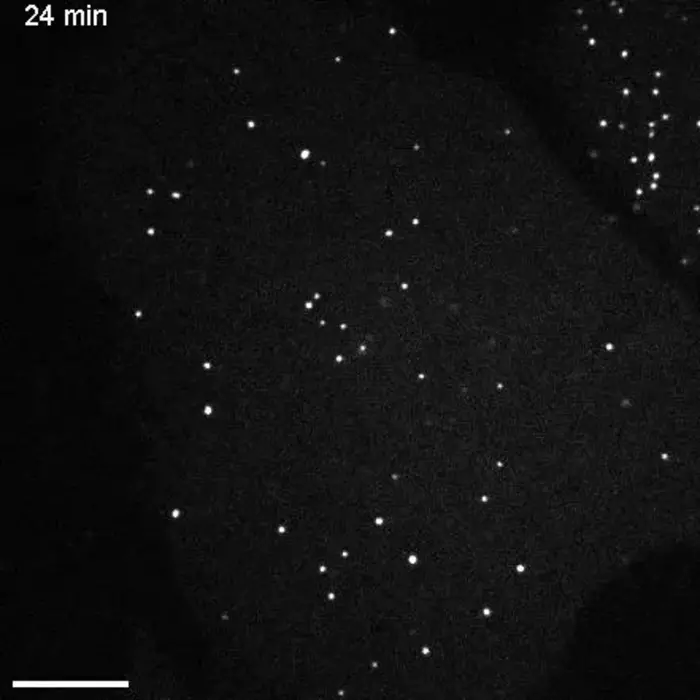
Researchers at the Hubrecht Institute are breaking new ground in the field of molecular biology with a revolutionary imaging technology that allows them to observe the intricate workings of ribosomes in real-time. The team, led by Maximilian Madern and Sora Yang, has successfully developed a technique that provides unprecedented insights into the process of mRNA translation, the critical step in protein synthesis. Published in the esteemed journal Cell, their findings reveal detailed behaviors of ribosomes and shed light on the cooperative dynamics that facilitate the translation process.
Ribosomes are often described as the molecular machines of the cell that translate messenger RNA (mRNA) into proteins. These proteins play essential roles in virtually all biological processes. The researchers’ novel imaging technique enables the visualization of individual ribosomes during translation, allowing scientists to monitor their movements and interactions within live cells. This advancement is monumental as it propels our understanding of how ribosomes function, particularly under challenging conditions that mRNA can sometimes present.
The significance of this research lies not only in its methodological ingenuity but also in its potential implications for understanding ribosomal behavior and efficiency. Traditional imaging methods often inability to capture the dynamic lifecycles of individual ribosomes over longer periods. The new technique leverages high-resolution microscopy and advanced imaging analysis, allowing for long-term observation. This has opened up a new avenue for scientists to explore the complexities of ribosome function in living cells continuously.
One fascinating discovery from their observations is the concept of ‘ribosome cooperativity.’ Madern articulates that, “In instances where one ribosome encounters a particularly challenging mRNA sequence, we discovered that other ribosomes can assist in navigating through the difficulties. This represents a paradigm shift in understanding ribosomal interactions.” The study finds that instead of faltering under pressure, ribosomes may actually synchronize their actions, leading to enhanced efficiency in protein synthesis.
Through their innovative approach, the researchers noted that individual ribosomes do not work in isolation; rather, they are influenced by the presence and performance of neighboring ribosomes. This notion upends conventional views that treated ribosome activity as independent events. The phenomenon of ribosomal collisions, wherein one ribosome may interrupt the path of another due to speed disparities, was also re-evaluated. Previously thought to be detrimental, these interactions could play a beneficial role in the translation of complex mRNA segments.
In the intricate dance of protein synthesis, ribosomes can exhibit notable variations in their translating speed. Some ribosomes may move swiftly, while others may require longer timeframes to decode mRNA segments. This variation can lead to collisions; however, the researchers found that such collisions do not necessarily evoke an immediate cellular response. Rather, the ribosomes seem to collaborate to overcome translation hurdles, exhibiting remarkable adaptability—what the researchers term ‘ribosome cooperativity.’
This extended view into ribosome behavior offers a treasure trove of information that can aid scientists in further unraveling the mechanisms of mRNA translation. By demonstrating that ribosomes can help each other, the researchers highlight a profound level of complexity in cellular processes previously underappreciated. As cells rely on the accurate translation of mRNA into proteins for proper functionality, understanding ribosome dynamics has far-reaching implications for both basic research and therapeutic interventions.
The impact of these findings extends to various fields, including developmental biology, genetics, and even medical research. Abnormalities in protein synthesis can lead to numerous diseases, including cancer and neurodegenerative disorders. Insights gained from this research may offer new avenues for therapeutic strategies targeting disrupted ribosome activity, ultimately leading to more effective treatments and interventions.
The researchers’ collaborative effort also brought in computational specialists from TU Delft’s Department of Bionanoscience. Their expertise was vital in interpreting the imaging data and providing a quantitative analysis of ribosome behavior. This interdisciplinary collaboration showcased the depth of modern scientific inquiry where diverse expertise converges to address complex biological questions.
In summary, the Hubrecht Institute’s groundbreaking work demonstrates that ribosomes are not just passive players in the protein synthesis arena. Instead, they are active participants capable of aiding one another, thus enhancing the efficiency and fidelity of translation. The implications of this work are vast, paving the way for future research that could lead to innovative insights in cellular biology and beyond. As science continues to delve deeper into the molecular tapestry of life, this new understanding of ribosome behavior stands to reshape our knowledge of fundamental biological processes.
Looking forward, the team plans to apply their imaging technology to explore various aspects of protein synthesis and investigate how different conditions, such as stress, may affect ribosomal function. By understanding these environments, researchers can further elucidate the relationship between ribosome dynamics and cellular health. The potential applications of this research are immense, raising exciting possibilities for future studies.
As the scientific community embraces this exciting advance in microscopy and molecular biology, the findings by the Hubrecht Institute serve as an inspiring reminder of the depths still to uncover in cellular mechanics. These discoveries are not merely academic; they have profound implications for our understanding of health and disease, as well as the basic principles of life itself.
Subject of Research: Cells
Article Title: Long-term imaging of individual ribosomes reveals ribosome cooperativity in mRNA translation
News Publication Date: 31-Jan-2025
Web References: Hubrecht Institute
References: DOI: 10.1016/j.cell.2025.01.016
Image Credits: Maximilian Madern, copyright Hubrecht Instituut
Keywords
mRNA translation
Ribosomes
Cellular physiology
Molecular genetics
Tags: challenges in mRNA translationcollaborative ribosomal behaviorHubrecht Institute researchimplications for protein synthesis efficiencyinnovative imaging methods in biologylive cell imaging techniquesmolecular biology advancementsmRNA translation dynamicsprotein synthesis mechanismsreal-time observation of ribosomesribosome function under stressribosome imaging technology





